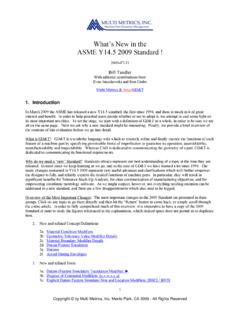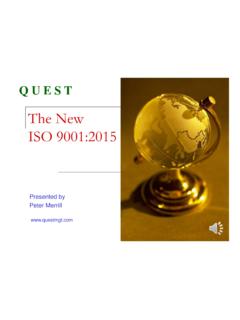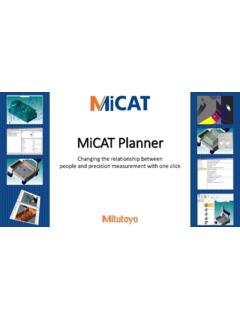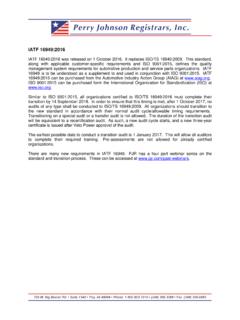Transcription of IATF 16949:2016 Transition Experiences - Quality …
1 DNV GL 2013 SAFER, SMARTER, GREENERDNV GL 2013 iatf 16949 : 2016 Transition ExperiencesIsmael Belmarez & Wendy Parr1 March 2017 Business Assurance USADNV GL and Consultant are acting in cooperation to provide this Webinar purely as an informational session to attendees and no relationship should be implied between DNV GL and Consultant. Participation in this Webinar does not construe a request for auditing or certification services nor implies any relationship between DNV GL and Consultant. DNV GL remains impartial and does not recommend or endorse individual consulting companies or seek to influence clients in deciding whether to use a consulting company or which to GL 2013 Transition Timing Requirements After 1 October 2017 no audits (initial, surveillance, recertification or transfer) shall be conducted to ISO/TS 16949 :2009.
2 Organizations certified to ISO/TS 16949 :2009 shall Transition to the new iatf 16949 , through a Transition audit in line with the current audit cycle for ISO/TS 16949 :2009 ( at a regularly scheduled recertification audit or surveillance audit), according to the allowable timing requirements defined in the iatf Rules, section GL 2013 Transition Timing Requirements The timing requirements are as follows: Failure to conduct a Transition audit according to the timing in the iatf Rules, section (or the timing of the decertification process in the iatf Rules, section ) requires the organization to start over with an initial certification audit3 DNV GL 2013 Transition Audit Requirements The Transition audit shall be the duration of a recertification audit according to the iatf Rules, Table The Transition audit shall be a full systems audit equivalent to a recertification audit and shall comply with all requirements defined in the iatf Rules, section A documentation review is required to be performed prior to the audit.
3 If the information is not provided prior to the audit additional time will be added to the Transition GL 2013 Transition Audit Requirements The Transition audit will include all RSLs associated with the manufacturing location. The new certificate will be issued for 3 years once all NCs have been addressed. Note1: There is no requirement for auditor rotation at the Transition Audit Note2: Organizations are not allowed to transfer and Transition at the same GL 2013 Additional Resources DNV Automotive Website iatf Website GL 2013 SAFER, SMARTER, GREENERDNV GL 2013 iatf 16949 : 2016 Implementation OverviewWendy ParrSuggested implementation steps and key requirementsDNV GL 2013 ISO 9001:2015 & iatf 16949 : 2016 ISO 9001 iatf 16949 APQPPPAPFMEAMSASPCIATF rulebookCustomer-Specific RequirementsDNV GL 2013 iatf 16949 Implementation Overview -Agenda ISO 9001:2015 Core Implementation Requirements Noted iatf sustainability requirements Other noteworthy additionsDNV GL 2013 ISO 9001.
4 2015 Core Implementation Requirements DNV GL 2013 Implementation Steps 1-31 Context2 Interested party needs3 ScopeWhile many Quality Management Systems have been in place for some time, these steps mustbe taken as they are the foundation of the GL 2013#1 Context ( ) Combination of internal and external issues that can have an effect on an organization s approach to developing and achieving its objectives. ISO 9000:2015 DNV GL 2013#1 Context ( ) Issues can include positive and negative factors or conditions for consideration Understanding the external context can be facilitated by considering issues arising from legal, technological, competitive, market, cultural, social and economic environments, whether international, national, regional or local Understanding the internal context can be facilitatedby considering issues related to values, culture, knowledge and performance of the organizationDNV GL 2013#1 Context ( ) Not required to be documented but must be monitored and reviewed Therefore, it is suggested that it be documented ( Quality Manual)
5 The registrar uses this information to ensure the scope is correct and overall risk factors are consideredDNV GL 2013#1 Context How to SWOT Strengths Weaknesses Opportunities Threats Many organizations have most or all of a context statement already defined on their web sitesDNV GL 2013 Context ExampleMaster Machining Company was founded by Mike Master with a vision to provide customers with the finest in precision machined parts built with reliability and excellence without compromise. Located in Chicago, IL, MMC fabricates a comprehensive range of close tolerance component parts from steel, aluminum, stainless, titanium, brass, copper and plastic. MMC prides itself on its unparalleled precision machining techniques, quick turnaround times and the highest Quality , complete-to-print is proficient at producing low volume prototype to large volume runs on our state of the art multi-axis CNC machines for hydraulic, automotive, medical, and other GL 2013 Context ExampleIn the manufacturing industry there are many specialists with narrowly focused core competencies.
6 MMC is confident that we have the best blend of skills and capabilities that this industry has to offer, in addition we have assembled the resources and expertise to offer the convenience of a one-stop, full service shop. We have an excellent relationship with top area businesses specializing in plating, grinding, honing, heat treating and a lot of other pre and post machining processes. We leverage our strengths and those of our partners, saving you missed deadlines, substandard Quality , time and GL 2013#2 Interested Parties ( ) Person or organization that can affect, be affected by, or perceive themselves to be affected by a decision or activity .ISO 9000:2015 Not required to be documented but must be monitored and reviewed Therefore, it is suggested that it be documented ( Quality Manual)DNV GL 2013#2 Interested Parties ( ) The registrar uses this information to ensure that processes and objectives consider all relevantinterested partiesDNV GL 2013#2 Interested Parties ExampleInterested PartyNeeds & ExpectationsCustomers Product/Servicemeets specifications On-Time Billed correctly Supply of technical expertise Prompt resolution of problemsOwner Make money Imagein marketplaceEmployees Make money Desirableplace to work Career advancementExternal Providers Clear requirements On-timepayment Required lead timeDNV GL 2013#3 Scope ( )
7 No significant changes in the requirement of the standard Confirm that it is correct as changes sometimes occur over time Supporting functions External locations Products Exclusions? product design Customer-Specific Requirement Consult with your registrar if there are questionsDNV GL 2013 Implementation Steps 4 -64 Processes Definition5 Risk Assessment6 ControlsDNV GL 2013# 4 Process Definition ( )a) determine the inputs required and the outputs expected from these processes;b) determine the sequence and interaction of these processes;c) determine and apply the criteria and methods (including monitoring, measurements and related performance indicators) needed to ensure the effective operation and control of these processes;d) determine the resources needed for these processes and ensure their availability;DNV GL 2013# 4 Process Definition ( )e) assign the responsibilities and authorities for these processes.
8 F) address the risks and opportunities as determined in accordance with the requirements of ;g) evaluate these processes and implement any changes needed to ensure that these processes achieve their intended results;h) improve the processes and the Quality management GL 2013# 4 Process Definition ( ) Before you can perform a risk assessment, you must have good process definition Process Identification / Procedure template Inputs/outputs Sequence and interaction Criteria and methods to ensure effective operation and control Resources Responsibilities Risks and opportunities ObjectivesDNV GL 2013If your current process diagram looks something like this, you probably have not defined your processes adequatelyDNV GL 2013 CustomerQuoting and Contract ReviewQP01 Production controlQP03 Quality PlanningQP02 Purchasing / Supplier ControlQP04 ProductionQP05 Outsourced -PackagingShippingQP06 CustomerSupport ProcessesDocument / Record Control QP07 Management Review QP08 MaintenanceCalibration QP09 Internal Audit QP10 Control of Nonconforming Product QP11 Corrective and Preventive Action QP12 Corporate ITCorporate AccountingCorporate HRProduct Design QP13If your process diagram looks more like this, you likely have a good understanding of processesDNV GL 2013#5 Risk Assessment / Analysis iatf 16949 requires the risk analysis to be retained as documented information ( ) Applies to all processes.
9 Not just PFMEA Options:A Risk assessment for all processes togetherB PFMEA + risk assessment for all other processesDNV GL 2013 Risk Assessment ProcessInputsHistorical Nonconformances* Data Potential RisksProcessOutputsRisk Assessment ResultsManagement Review ISO 9001 Action Process ISO 9001 controls / improve ProcessRisk AssessmentToolQATM*Nonconformances: Lessons learned from product recalls, product audits, field returns and repairs, complaints scrap and rework ( )DNV GL 2013 Risk Assessment Tool DiscussionDNV GL 2013 Risk Assessment MethodologyVersion:1 Process #Process NamePotential FailuresPotential ConsequenceSeverityPotential Cause of FailureLikelihoodCurrent Prevention / controlsCurrent Detection Contract Services -samplingunacceptable samplelost sale3 Incomplete, inaccurate Sample Request2 Completion of Sample Request Form prior to sample run1st piece visual inspection, weight, & durometer16unacceptable samplelost sale3 Personnel have insufficient training and/or knowledge3 General Training and general procedure1st piece visual inspection, weight, & Contract Services -1st time production ordernonconforming production partsrework / additional labor / late shipment2 Insufficient documentation of sample run / inadequate planning2 Complete sample outputs.
10 Approved Sample Report, notes, pictures, drawing changes1st piece visual inspection, weight, & durometer14parts not to customer specificationscustomer dissatisfaction3 Overlooking customer requirements2 Quality Planning Review / release of Pre-production form1st piece visual inspection, weight, & durometer16parts not to customer specificationscustomer dissatisfaction3 Personnel have insufficient training and/or knowledge3 General Training and general procedure1st piece visual inspection, weight, & & Order Acceptance -Quoting(chemicals)incorrect information to customercustomer dissatisfaction3 Pricing Data inaccurate1documented quote requiredPresident / Project Coordinator reviews/approves13incorrect information to customercustomer dissatisfaction3 Personnel have insufficient training and/or knowledge1 System mistake-proofs process and procedure is detailedPresident / Project Coordinator reviews/approves13 DNV GL 2013 Severity of failure ratings:1 -little impact on customer / company2 -medium impact on operational efficiency and/or KPIs / little impact on customer3 -customer satisfaction impactedLikelihood of failure ratings:1 -has not happened in past and not very likely to happen in future2 -has happened in past but not very likely to happen in future3 -has occurred and has potential to occur in futureDetection of failure ratings.













